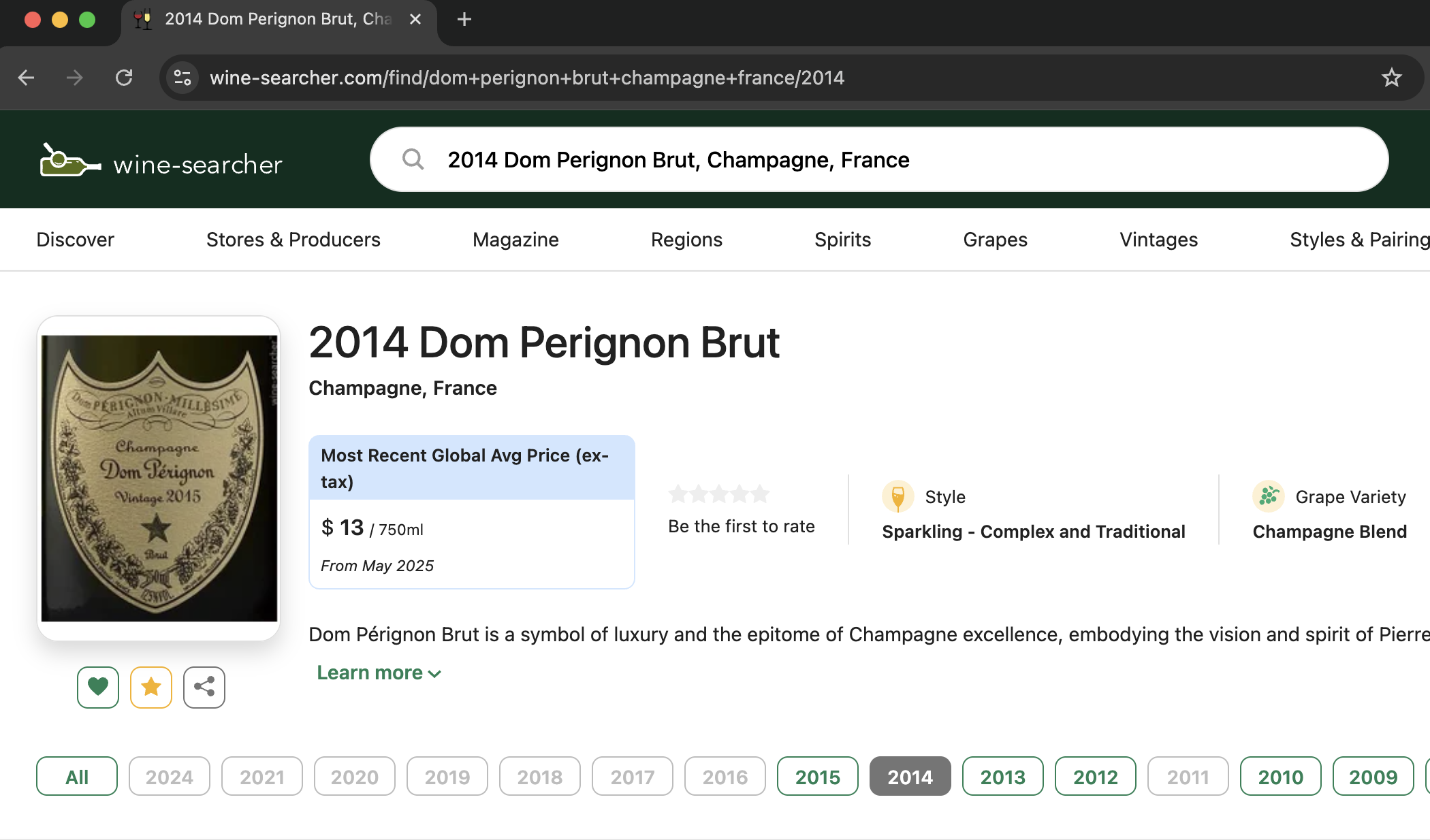- Published on
- Published
Introducing ELID: The Universal Wine Identification System for Humanity and AI
- Authors

- Name
- Rijnard van Tonder
- @rvtond
Picture this: you're at your favorite wine bar, staring at a list that describes a bottle as "Dom Perignon Brut 2012." Later, somewhere else, you see "Dom Pérignon Champagne Brut 2012." Online, it might appear as "Champagne Dom Perignon Brut Vintage 2012." Same wine, three different ways to say it. The naming is inconsistent and makes comparison nearly impossible.
This problem led me to develop ELID (Easily Legible IDs for Wine), a standardized wine identification system that brings consistency to the wine naming problem.
A Problem Worth Solving
Wine identification is broken. Visit any wine shop, restaurant, or cellar management app, and you'll find the same wines listed with completely different names. Producers might be spelled differently, regions abbreviated inconsistently, and vintage information placed randomly. This creates three major headaches:
Price Comparison Problems: Try comparing prices across different wine lists. Even with identical wines, varying names make automated comparison nearly impossible. You end up manually cross-referencing, which takes time and introduces errors.
Inventory Management Issues: Wine collectors and cellar managers struggle when the same bottle appears multiple times in their systems under different names. This leads to duplicate purchases and confusion about what's actually in stock.
Scattered Reviews: Wine reviews, ratings, and tasting notes get scattered across different naming conventions. Finding all information about a specific wine becomes an archaeological expedition through inconsistent (and even proprietary) databases.
Enter ELID: One Wine, One ID
ELID solves this by giving every wine a single, standardized identifier that looks like this:
FR-CHA-DOMP01-2012
This represents Dom Perignon Brut 2012 from Champagne, France. Let's break it down:
- FR: Country (France)
- CHA: Region (Champagne)
- DOMP01: Producer and wine (Dom Perignon, wine #01)
- 2012: Vintage year
Every component follows strict formatting rules, ensuring consistency across all platforms, languages, and regions.
Why ELID Changes Everything
Standardized Identification: No more guessing whether "Dom Perignon" and "Dom Pérignon" refer to the same producer. ELID creates one consistent way to identify wines across all sources.
Cross-Platform Price Comparison: Restaurants, wine shops, and online retailers can now enable real-time price comparison. Customers instantly see if they're getting a good deal, and businesses can price competitively with confidence.
Hierarchical Intelligence: The ID structure is information rich. Even without a database lookup, you know this wine is from France's Champagne region, produced by Dom Perignon. The geographic hierarchy enables regional analysis and discovery.
Error Detection: Misspelled producer names or incorrect regions become immediately obvious when they don't match existing ELID patterns. This catches mistakes before they propagate through systems. Vintages are verified where possible (e.g., 2014 Dom Pérignon never has, and never will, exist). Your favorite wine search tool may (wrongly) believe otherwise.

Data Integration: Merging wine data from multiple sources becomes straightforward when everything shares the same identification standard. Reviews, prices, and inventory can finally speak the same language.
Knowledge Graph Foundation: ELID naturally creates relationships between wines, producers, and regions. This enables analysis like tracking price trends across specific appellations or comparing vintages from the same producer.
Perfect for the AI Era
Everyone is so eager to integrate with AI, but here's the thing: Current systems are terrible, so you're giving AI something terrible to work with. It can summarize some great picks on a wine list (what, hundreds to thousands of wines?) but it can't aggregate and cross-check millions of price listings without doing a lot of work to un-chaos things. AI is tolerant to inconsistency, but that doesn't make it efficient. Consistent wine data structures enable it to thrive.
ELID is the structured format tht AI systems need: predictable, hierarchical data that embeds meaning directly in the identifier. When an AI sees FR-ECH-DRCO02-2012 it immediately knows the geographic context, producer scope, and vintage without any database lookup or fuzzy matching.
Regional preferences, vintage characteristics, and producer styles all become trainable because the data structure is stable. No more guessing whether "Burgundy" and "Bourgogne" refer to the same region, or whether "DRC" and "Domaine de la Romanée-Conti" are the same producer.
Want to train a model to understand terroir? The geographic hierarchy is right there. Building a recommendation engine? The producer codes create natural groupings. Analyzing vintage patterns? Just sort by the last four characters.
Instead of forcing AI to work with messy wine data, ELID gives machines exactly what they actually need: structure they can count on.
Real-World Applications
ELID was developed largely to support universal price comparison and benchmarking across the entire earth's collective wine list.
It enables wine outlets to offer customers instant price comparisons across their region. Cellar management apps eliminate duplicate entries automatically. Wine reviewers can aggregate all opinions about a specific wine regardless of how it was originally named. Restaurant sommeliers can quickly verify accurate producer, wine region, and vintage deails being served.
The system handles everything from prestigious Bordeaux first growths to small natural wine producers. Regional codes adapt to local classification systems while maintaining global consistency.
Technical Implementation
ELID follows a formal specification that handles special cases, alternative names, and regional variations. The full technical documentation provides implementation guidelines for developers integrating ELID into existing wine systems.
Each ELID component uses specific character limits and formatting rules. Countries follow ISO standards where applicable. Regions map to established wine classifications. Producer codes ensure uniqueness while remaining human-readable.
Why Not Just Use LWIN?
Yes, there's LWIN. LWIN is great. I love LWIN. LWIN doesn't cut it.
The Liv-ex Wine Identification Number (LWIN) is the most complete dataset for uniquely identifying wines, and I have tremendous respect for what they've built. In fact, I used the LWIN database extensively to generate ELID codes. But here's where LWIN falls short for everyday wine applications:
Numeric Soup: A LWIN like 1004033 tells you absolutely nothing about the wine. It's just a lookup key that requires an external database to be meaningful. Want Bordeaux? Look for FR-BDX-* with ELID.
Trade-Focused, Not User-Focused: LWIN was designed for wine trading, with extensions for case sizes and bottle capacities. It doesn't serve customers in find similar wines or inventory organization by region / producer / ...
Incomplete Coverage: LWIN focuses on fine wine and doesn't cover every producer. Since it's a commercial database, many smaller producers and natural wine makers simply aren't included.
ELID builds on LWIN's foundation but optimizes for a different problem: making wine identification intuitive and self-contained. Where LWIN says "here's a number, go look it up," ELID says "here's the essentials you need to know, encoded in a readable format."
The two systems are largely compatible. Most LWINs can be converted to ELIDs and vice versa. But ELID enables applications that would be clunky or impossible with pure numeric identifiers.
The Path Forward
ELID is the future-proof foundation for better wine experiences. When everyone speaks the same language about wine, honest businesses can embrace transparency and deliver true value. Benchmarking prices with markup transparency for greater consumer loyalty and incentive.
Continuous, real-time pricing that responds to dynamic global market conditions. Cellaring tech and recommendations identify regional and stylistic preferences with pinpoint accuracy. Review systems, curation, and and wine ranking accurately identifies this bottle, not to be confused with that bottle.
The system already covers thousands of wines and continues expanding through community contributions and automated data integration.
Vantage: Wine List Data Platform
The comprehensive platform for wine list data analysis and management. See comparative pricing across markets and help build the transparent wine ecosystem. Built for industry professionals ready to be part of the solution.
Access & Collaboration 👉 [email protected]

